Treatment of Industrial Wastewater in a Floating Treatment Wetland: A Case Study of Sialkot Tannery
Abstract
:1. Introduction
2. Current Problems and Prospects of Using Plants for Wastewater Treatment
3. Methodology
3.1. Study Area
3.2. Sample Collection and Analysis
4. Results and Discussion
4.1. Water Hyacinth
4.2. Water Lettuce
4.3. Typha Latifolia
5. Conclusions
Author Contributions
Funding
Institutional Review Board Statement
Informed Consent Statement
Data Availability Statement
Acknowledgments
Conflicts of Interest
References
- Montaño-Medina, C.U.; Lopéz-Martínez, L.M.; Ochoa-Terán, A.; López-Maldonado, E.A.; Salazar-Gastelum, M.I.; Trujillo-Navarrete, B.; Pérez-Sicairos, S.; Cornejo-Bravo, J.M. New pyridyl and aniline-functionalized carbamoylcarboxylic acids for removal of metal ions from water by coagulation-flocculation process. Chem. Eng. J. 2023, 451, 138396. [Google Scholar] [CrossRef]
- Shahid, M.; Al-Surhanee, A.; Kouadri, F.; Ali, S.; Nawaz, N.; Afzal, M.; Rizwan, M.; Ali, B.; Soliman, M. Role of Microorganisms in the Remediation of Wastewater in Floating Treatment Wetlands: A Review. Sustainability 2020, 12, 5559. [Google Scholar] [CrossRef]
- Eljamal, O.; Sasaki, K.; Hirajima, T. Sorption Kinetic of Arsenate as Water Contaminant on Zero Valent Iron. J. Water Resour. Prot. 2013, 5, 563–567. [Google Scholar] [CrossRef] [Green Version]
- D’Adamo, I.; Gastaldi, M.; Morone, P.; Rosa, P.; Sassanelli, C.; Settembre-Blundo, D.; Shen, Y. Bioeconomy of Sustainability: Drivers, Opportunities and Policy Implications. Sustainability 2021, 14, 200. [Google Scholar] [CrossRef]
- Sikander, M.; Kumar, L.; Naqvi, S.A.; Arshad, M.; Jabeen, S. Sustainable practices for reduction of environmental footprint in tanneries of Pakistan. Case Stud. Chem. Environ. Eng. 2021, 4, 100161. [Google Scholar] [CrossRef]
- Cheng, Q.; Huang, Q.; Khan, S.; Liu, Y.; Liao, Z.; Li, G.; Ok, Y.S. Adsorption of Cd by peanut husks and peanut husk biochar from aqueous solutions. Ecol. Eng. 2016, 87, 240–245. [Google Scholar] [CrossRef]
- Sarode, S.; Upadhyay, P.; Khosa, M.; Mak, T.; Shakir, A.; Song, S.; Ullah, A. Overview of wastewater treatment methods with special focus on biopolymer chitin-chitosan. Int. J. Biol. Macromol. 2018, 121, 1086–1100. [Google Scholar] [CrossRef]
- Genet, M.; Stokes, A.; Fourcaud, T.; Norris, J.E. The influence of plant diversity on slope stability in a moist evergreen deciduous forest. Ecol. Eng. 2010, 36, 265–275. [Google Scholar] [CrossRef]
- Khan, S.; Waqas, M.; Ding, F.; Shamshad, I.; Arp, H.P.H.; Li, G. The influence of various biochars on the bioaccessibility and bioaccumulation of PAHs and potentially toxic elements to turnips (Brassica rapa L.). J. Hazard. Mater. 2015, 300, 243–253. [Google Scholar] [CrossRef]
- D’Adamo, I.; Sassanelli, C. A mini-review of biomethane valorization: Managerial and policy implications for a circular resource. Waste Manag. Res. 2022, 1–12. [Google Scholar] [CrossRef]
- Fu, F.; Wang, Q. Removal of heavy metal ions from wastewaters: A review. J. Environ. Manag. 2011, 92, 407–418. [Google Scholar] [CrossRef] [PubMed]
- Kurniawan, T.A.; Chan, G.Y.; Lo, W.-H.; Babel, S. Physico–chemical treatment techniques for wastewater laden with heavy metals. Chem. Eng. J. 2006, 118, 83–98. [Google Scholar] [CrossRef]
- Marinho, B.A.; Cristóvão, R.O.; Boaventura, R.A.R.; Vilar, V.J.P. As(III) and Cr(VI) oxyanion removal from water by advanced oxidation/reduction processes—A review. Environ. Sci. Pollut. Res. 2018, 26, 2203–2227. [Google Scholar] [CrossRef] [PubMed]
- Carolin, C.F.; Kumar, P.S.; Saravanan, A.; Joshiba, G.J.; Naushad, M. Efficient techniques for the removal of toxic heavy metals from aquatic environment: A review. J. Environ. Chem. Eng. 2017, 5, 2782–2799. [Google Scholar] [CrossRef]
- Bolisetty, S.; Peydayesh, M.; Mezzenga, R. Sustainable technologies for water purification from heavy metals: Review and analysis. Chem. Soc. Rev. 2019, 48, 463–487. [Google Scholar] [CrossRef]
- Weng, C.-H.; Lin, Y.-T.; Hong, D.-Y.; Sharma, Y.C.; Chen, S.-C.; Tripathi, K. Effective removal of copper ions from aqueous solution using base treated black tea waste. Ecol. Eng. 2014, 67, 127–133. [Google Scholar] [CrossRef]
- Calheiros, C.; Rangel, A.; Castro, P. Constructed Wetlands for Tannery Wastewater Treatment in Portugal: Ten Years of Experience. Int. J. Phytoremediation 2014, 16, 859–870. [Google Scholar] [CrossRef]
- Kumar, L.; Nadeem, F.; Sloan, M.; Restle-Steinert, J.; Deitch, M.J.; Naqvi, S.A.; Kumar, A.; Sassanelli, C. Fostering Green Finance for Sustainable Development: A Focus on Textile and Leather Small Medium Enterprises in Pakistan. Sustainability 2022, 14, 11908. [Google Scholar] [CrossRef]
- Sassanelli, C.; Rosa, P.; Rocca, R.; Terzi, S. Circular economy performance assessment methods: A systematic literature review. J. Clean. Prod. 2019, 229, 440–453. [Google Scholar] [CrossRef]
- Acerbi, F.; Sassanelli, C.; Terzi, S.; Taisch, M. A Systematic Literature Review on Data and Information Required for Circular Manufacturing Strategies Adoption. Sustainability 2021, 13, 2047. [Google Scholar] [CrossRef]
- Acerbi, F.; Sassanelli, C.; Taisch, M. A conceptual data model promoting data-driven circular manufacturing. Oper. Manag. Res. 2022, 1–20. [Google Scholar] [CrossRef]
- Memedovic, O.; Mattila, H. The global leather value chain: The industries, the main actors and prospects for upgrading in LDCs. Int. J. Technol. Learn. Innov. Dev. 2008, 1, 482. [Google Scholar] [CrossRef]
- Memon, Y.I.; Qureshi, S.S.; Kandhar, I.A.; Qureshi, N.A.; Saeed, S.; Mubarak, N.; Khan, S.U.; Saleh, T.A. Statistical analysis and physicochemical characteristics of groundwater quality parameters: A case study. Int. J. Environ. Anal. Chem. 2021, 1–22. [Google Scholar] [CrossRef]
- Jiang, W.; Yuan, Z.; Bi, J.; Sun, L. Conserving water by optimizing production schedules in the dyeing industry. J. Clean. Prod. 2010, 18, 1696–1702. [Google Scholar] [CrossRef]
- Rottle, N.; Bowles, M.; Andrews, L.; Engelke, J. Constructed floating wetlands: A “s afe-to-fail” study with m ulti-sector participation. Restor. Ecol. 2022, e13672. [Google Scholar] [CrossRef]
- Castellar, J.A.; Torrens, A.; Buttiglieri, G.; Monclús, H.; Arias, C.A.; Carvalho, P.N.; Galvao, A.; Comas, J. Nature-based solutions coupled with advanced technologies: An opportunity for decentralized water reuse in cities. J. Clean. Prod. 2022, 340, 130660. [Google Scholar] [CrossRef]
- Unnithan, M.R.; Vinod, V.P.; Anirudhan, T.S. Synthesis, Characterization, and Application as a Chromium(VI) Adsorbent of Amine-Modified Polyacrylamide-Grafted Coconut Coir Pith. Ind. Eng. Chem. Res. 2004, 43, 2247–2255. [Google Scholar] [CrossRef]
- Faulwetter, J.L.; Burr, M.D.; Cunningham, A.B.; Stewart, F.M.; Camper, A.K.; Stein, O.R. Floating treatment wetlands for domestic wastewater treatment. Water Sci. Technol. 2011, 64, 2089–2095. [Google Scholar] [CrossRef] [Green Version]
- Somprasert, S.; Mungkung, S.; Kreetachat, N.; Imman, S.; Homklin, S. Implementation of an Integrated Floating Wetland and Biofilter for Water Treatment in Nile Tilapia Aquaculture. J. Ecol. Eng. 2021, 22, 146–152. [Google Scholar] [CrossRef]
- Uysal, Y. Removal of chromium ions from wastewater by duckweed, Lemna minor L. by using a pilot system with continuous flow. J. Hazard. Mater. 2013, 263, 486–492. [Google Scholar] [CrossRef] [PubMed]
- Pascual, A.; De La Varga, D.; Arias, C.A.; Van Oirschot, D.; Kilian, R.; Álvarez, J.A.; Soto, M. Hydrolytic anaerobic reactor and aerated constructed wetland systems for municipal wastewater treatment—Highwet project. Environ. Technol. 2016, 38, 209–219. [Google Scholar] [CrossRef] [PubMed]
- DalCorso, G.; Fasani, E.; Manara, A.; Visioli, G.; Furini, A. Heavy Metal Pollutions: State of the Art and Innovation in Phytoremediation. Int. J. Mol. Sci. 2019, 20, 3412. [Google Scholar] [CrossRef] [Green Version]
- Afzal, M.; Arslan, M.; Müller, J.A.; Shabir, G.; Islam, E.; Tahseen, R.; Anwar-Ul-Haq, M.; Hashmat, A.J.; Iqbal, S.; Khan, Q.M. Floating treatment wetlands as a suitable option for large-scale wastewater treatment. Nat. Sustain. 2019, 2, 863–871. [Google Scholar] [CrossRef]
- Weragoda, S.K.; Jinadasa, K.B.S.N.; Zhang, D.Q.; Gersberg, R.M.; Tan, S.K.; Tanaka, N.; Jern, N.W. Tropical Application of Floating Treatment Wetlands. Wetlands 2012, 32, 955–961. [Google Scholar] [CrossRef]
- Guerrero, C.M.; Travis, G. Assessing Decentralized Wastewater Treatment Options in SantaBarbara Count; Taylor & Francis Group: Oxfordshire, UK, 2009. [Google Scholar]
- Dotro, G.; Langergraber, G.; Molle, P.; Nivala, J.; Puigagut, J.; Stein, O.; von Sperling, M. Treatment Wetlands. 2017. Available online: https://library.oapen.org/handle/20.500.12657/31049 (accessed on 22 September 2022).
- Walker, C.; Tondera, K.; Lucke, T. Stormwater Treatment Evaluation of a Constructed Floating Wetland after Two Years Operation in an Urban Catchment. Sustainability 2017, 9, 1687. [Google Scholar] [CrossRef] [Green Version]
- Lucke, T.; Walker, C.; Beecham, S. Experimental designs of field-based constructed floating wetland studies: A review. Sci. Total Environ. 2019, 660, 199–208. [Google Scholar] [CrossRef]
- Abed, S.N.; Almuktar, S.A.; Scholz, M. Remediation of synthetic greywater in mesocosm—Scale floating treatment wetlands. Ecol. Eng. 2017, 102, 303–319. [Google Scholar] [CrossRef]
- Shahid, M.J.; Arslan, M.; Ali, S.; Siddique, M.; Afzal, M. Floating Wetlands: A Sustainable Tool for Wastewater Treatment. CLEAN—Soil Air Water 2018, 46, 1800120. [Google Scholar] [CrossRef]
- Johnson, S. Literature Review: Pollutant Removal Efficacy of Floating Treatment Wetlands across Water Bodies. Bachelor’s Thesis, Portland State University, Portland, OR, USA, 2021. [Google Scholar] [CrossRef]
- Winston, R.J.; Hunt, W.F.; Kennedy, S.G.; Merriman, L.S.; Chandler, J.; Brown, D. Evaluation of floating treatment wetlands as retrofits to existing stormwater retention ponds. Ecol. Eng. 2013, 54, 254–265. [Google Scholar] [CrossRef]
- Pavlidis, G.; Zotou, I.; Karasali, H.; Marousopoulou, A.; Bariamis, G.; Tsihrintzis, V.A.; Nalbantis, I. Performance of Pilot-scale Constructed Floating Wetlands in the Removal of Nutrients and Pesticides. Water Resour. Manag. 2021, 36, 399–416. [Google Scholar] [CrossRef]
- Abdelhakeem, S.G.; Aboulroos, S.A.; Kamel, M.M. Performance of a vertical subsurface flow constructed wetland under different operational conditions. J. Adv. Res. 2016, 7, 803–814. [Google Scholar] [CrossRef] [Green Version]
- Eljamal, O.; Thompson, I.P.; Maamoun, I.; Shubair, T.; Eljamal, K.; Lueangwattanapong, K.; Sugihara, Y. Investigating the design parameters for a permeable reactive barrier consisting of nanoscale zero-valent iron and bimetallic iron/copper for phosphate removal. J. Mol. Liq. 2019, 299, 112144. [Google Scholar] [CrossRef]
- Rahmadyanti, E. Integrated System of Biofilter and Constructed Wetland for Sustainable Batik Industry. Int. J. GEOMATE 2020, 18, 138–148. [Google Scholar] [CrossRef]
- García-Valero, A.; Martínez-Martínez, S.; Faz, Á.; Terrero, M.A.; Muñoz, M.; Gómez-López, M.D.; Acosta, J.A. Treatment of WASTEWATER from the Tannery Industry in a Constructed Wetland Planted with Phragmites australis. Agronomy 2020, 10, 176. [Google Scholar] [CrossRef] [Green Version]
- Saeed, T.; Khan, T. Constructed wetlands for industrial wastewater treatment: Alternative media, input biodegradation ratio and unstable loading. J. Environ. Chem. Eng. 2019, 7, 103042. [Google Scholar] [CrossRef]
- Calheiros, C.S.; Rangel, A.O.; Castro, P.M. Constructed wetland systems vegetated with different plants applied to the treatment of tannery wastewater. Water Res. 2007, 41, 1790–1798. [Google Scholar] [CrossRef]
- Salt, D.E.; Blaylock, M.; Kumar, N.P.B.A.; Dushenkov, V.; Ensley, B.D.; Chet, I.; Raskin, I. Phytoremediation: A Novel Strategy for the Removal of Toxic Metals from the Environment Using Plants. Nat. Biotechnol. 1995, 13, 468–474. [Google Scholar] [CrossRef] [PubMed]
- Shelef, O.; Gross, A.; Rachmilevitch, S. Role of Plants in a Constructed Wetland: Current and New Perspectives. Water 2013, 5, 405–419. [Google Scholar] [CrossRef]
- Calheiros, C.S.C.; Pereira, S.I.A.; Franco, A.R.; Castro, P.M.L. Diverse Arbuscular Mycorrhizal Fungi (AMF) Communities Colonize Plants Inhabiting a Constructed Wetland for Wastewater Treatment. Water 2019, 11, 1535. [Google Scholar] [CrossRef]
- Arliyani, I.; Tangahu, B.V.; Mangkoedihardjo, S. Plant Diversity in a Constructed Wetland for Pollutant Parameter Processing on Leachate: A Review. J. Ecol. Eng. 2021, 22, 240–255. [Google Scholar] [CrossRef]
- Rijkenberg, M.J.; Depree, C.V. Heavy metal stabilization in contaminated road-derived sediments. Sci. Total Environ. 2010, 408, 1212–1220. [Google Scholar] [CrossRef] [PubMed]
- Boelaert, F.; Amore, G.; van der Stede, Y.; Stoicescu, A.; Nagy, K.; Riolo, F.; Kleine, J.; Messens, W.; Lima, E.; Watts, M.; et al. The European Union summary report on trends and sources of zoonoses, zoonotic agents and food-borne outbreaks in 2014. EFSA J. 2015, 13, 4329. [Google Scholar] [CrossRef]
- Shen, S.; Li, X.; Lu, X. Recent developments and applications of floating treatment wetlands for treating different source waters: A review. Environ. Sci. Pollut. Res. 2021, 28, 62061–62084. [Google Scholar] [CrossRef]
- Priya, E.S.; Selvan, P.S. Water hyacinth (Eichhornia crassipes)—An efficient and economic adsorbent for textile effluent treatment—A review. Arab. J. Chem. 2017, 10, S3548–S3558. [Google Scholar] [CrossRef] [Green Version]
- Krämer, U. Metal Hyperaccumulation in Plants. Annu. Rev. Plant Biol. 2010, 61, 517–534. [Google Scholar] [CrossRef]
- Yu, C.; Peng, X.; Yan, H.; Li, X.; Zhou, Z.; Yan, T. Phytoremediation Ability of Solanum nigrum L. to Cd-Contaminated Soils with High Levels of Cu, Zn, and Pb. Water Air Soil Pollut. 2015, 226, 157. [Google Scholar] [CrossRef]
- Liang, Y.; Zhu, H.; Bañuelos, G.; Shutes, B.; Yan, B.; Cheng, X. Removal of sulfamethoxazole from salt-laden wastewater in constructed wetlands affected by plant species, salinity levels and co-existing contaminants. Chem. Eng. J. 2018, 341, 462–470. [Google Scholar] [CrossRef]
- Li, W.; Xu, X.; Fujibayashi, M.; Niu, Q.; Tanaka, N.; Nishimura, O. Response of microalgae to elevated CO2 and temperature: Impact of climate change on freshwater ecosystems. Environ. Sci. Pollut. Res. 2016, 23, 19847–19860. [Google Scholar] [CrossRef]
- Gacheva, G.; Gigova, L. Biological activity of microalgae can be enhanced by manipulating the cultivation temperature and irradiance. Open Life Sci. 2014, 9, 1168–1181. [Google Scholar] [CrossRef]
- Jafarinejad, S.; Jiang, S.C. Current technologies and future directions for treating petroleum refineries and petrochemical plants (PRPP) wastewaters. J. Environ. Chem. Eng. 2019, 7, 103326. [Google Scholar] [CrossRef]
- Tian, X.; Song, Y.; Shen, Z.; Zhou, Y.; Wang, K.; Jin, X.; Han, Z.; Liu, T. A comprehensive review on toxic petrochemical wastewater pretreatment and advanced treatment. J. Clean. Prod. 2020, 245, 118692. [Google Scholar] [CrossRef]
- Farraji, H.; Zaman, N.Q.; Tajuddin, R.M.; Faraji, H. Advantages and Disadvantages of Phytoremediation: A Concise Review. Int. J. Env. Tech. Sci. 2016, 2, 69–75. Available online: www.journalijets.org (accessed on 23 September 2022).
- Verhoeven, J.T.A.; Arheimer, B.; Yin, C.; Hefting, M.; Verhoeven, J.T.A.; Arheimer, B.; Yin, C.; Hefting, M.; Verhoeven, J.T.A.; Arheimer, B.; et al. Regional and global concerns over wetlands and water quality. Trends Ecol. Evol. 2006, 21, 96–103. [Google Scholar] [CrossRef] [PubMed]
- Ortolano, L.; Sanchez-Triana, E.; Afzal, J.; Ali, C.L.; Rebellón, S.A. Cleaner production in Pakistan’s leather and textile sectors. J. Clean. Prod. 2014, 68, 121–129. [Google Scholar] [CrossRef] [Green Version]
- Kumar, L.; Kamil, I.; Ahmad, M.; Naqvi, S.A.; Deitch, M.J.; Amjad, A.Q.; Kumar, A.; Basheer, S.; Arshad, M.; Sassanelli, C. In-house resource efficiency improvements supplementing the end of pipe treatments in textile SMEs under a circular economy fashion. Front. Environ. Sci. 2022, 10. [Google Scholar] [CrossRef]
- Khalili, N.R.; Duecker, S.; Ashton, W.; Chavez, F. From cleaner production to sustainable development: The role of academia. J. Clean. Prod. 2015, 96, 30–43. [Google Scholar] [CrossRef]
- Rizwan, U.; Malik, R.N.; Abdul, Q. Assessment of groundwater contamination in an industrial city, Sialkot, Pakistan. Afr. J. Environ. Sci. Technol. 2009, 3, 429–446. Available online: https://www.ajol.info/index.php/ajest/article/view/56273 (accessed on 2 September 2022).
- Qadir, A.; Malik, R.N. Assessment of an index of biological integrity (IBI) to quantify the quality of two tributaries of river Chenab, Sialkot, Pakistan. Hydrobiologia 2008, 621, 127–153. [Google Scholar] [CrossRef]
- Ghani, A.; Maalik, S. Assessment of diversity and relative abundance of insect fauna associated with Triticum aestivum from district Sialkot, Pakistan. J. King Saud Univ.-Sci. 2019, 32, 986–995. [Google Scholar] [CrossRef]
- Tüfekci, N.; Sivri, N.; Toroz, İ. Pollutants of Textile Industry Wastewater and Assessment of its Discharge Limits by Water Quality Standards. Turk. J. Fish. Aquat. Sci. 2007, 7, 97–103. [Google Scholar]
- Ayaz, T.; Khan, S.; Khan, A.Z.; Lei, M.; Alam, M. Remediation of industrial wastewater using four hydrophyte species: A comparison of individual (pot experiments) and mix plants (constructed wetland). J. Environ. Manag. 2019, 255, 109833. [Google Scholar] [CrossRef] [PubMed]
- Khan, S.; Ahmad, I.; Shah, M.T.; Rehman, S.; Khaliq, A. Use of constructed wetland for the removal of heavy metals from industrial wastewater. J. Environ. Manag. 2009, 90, 3451–3457. [Google Scholar] [CrossRef] [PubMed]
- Shehzadi, M.; Afzal, M.; Khan, M.U.; Islam, E.; Mobin, A.; Anwar, S.; Khan, Q.M. Enhanced degradation of textile effluent in constructed wetland system using Typha domingensis and textile effluent-degrading endophytic bacteria. Water Res. 2014, 58, 152–159. [Google Scholar] [CrossRef] [PubMed]
- Gholipour, A.; Zahabi, H.; Stefanakis, A.I. A novel pilot and full-scale constructed wetland study for glass industry wastewater treatment. Chemosphere 2020, 247, 125966. [Google Scholar] [CrossRef]
- Calheiros, C.S.; Quitério, P.V.; Silva, G.; Crispim, L.F.; Brix, H.; Moura, S.C.; Castro, P.M. Use of constructed wetland systems with Arundo and Sarcocornia for polishing high salinity tannery wastewater. J. Environ. Manag. 2012, 95, 66–71. [Google Scholar] [CrossRef] [Green Version]
- Mant, C.; Costa, S.; Williams, J.; Tambourgi, E. Phytoremediation of chromium by model constructed wetland. Bioresour. Technol. 2006, 97, 1767–1772. [Google Scholar] [CrossRef]
- Naseer, K.; Hashmi, I.; Arshad, M.; Gabriel, H.F. Performance Efficiency of a Large-Scale Integrated Constructed Wetland. J. Environ. Treat. Tech. 2021, 9, 629–635. [Google Scholar]
- Saadi, S.T.A.; Arshad, M.; Qammar, M.U.; Haq, M.A.U. Designing an efficient wetland by decision support system using experimental and modling approach. Pak. J. Agric. Sci. 2020, 57, 837–847. [Google Scholar] [CrossRef]
- Agarry, S.E.; Oghenejoboh, K.M.; Latinwo, G.K.; Owabor, C.N. Biotreatment of petroleum refinery wastewater in vertical surface-flow constructed wetland vegetated with Eichhornia crassipes: Lab-scale experimental and kinetic modelling. Environ. Technol. 2018, 41, 1793–1813. [Google Scholar] [CrossRef]
- Wichtmann, W.; Syndrom, C. The CINDERELLA Project: Paludiculture for GHG Emissions Mitigation in Peatlands Aim of the Project. Progressing Paludicultures after Centuries of Peatland Destruction and Neglect. 2017. Available online: http://www.imcg.net/media/2017/imcg_bulletin_1709.pdf (accessed on 2 September 2022).
- Geurts, J.J.M.; Fritz, C. Paludiculture Pilots and Experiments with Focus on Cattail and Reed in The Netherlands. Technical Report CINDERELLA Project FACCE-JPI ERA-NET Plus on Climate Smart Agriculture. 2018, pp. 1–71. Available online: https://repository.ubn.ru.nl/bitstream/handle/2066/192628/192628pub.pdf (accessed on 2 September 2022).
- Kantawanichkul, S.; Kladprasert, S.; Brix, H. Treatment of high-strength wastewater in tropical vertical flow constructed wetlands planted with Typha angustifolia and Cyperus involucratus. Ecol. Eng. 2009, 35, 238–247. [Google Scholar] [CrossRef]
- Dan, T.H.; Quang, L.N.; Chiem, N.H.; Brix, H. Treatment of high-strength wastewater in tropical constructed wetlands planted with Sesbania sesban: Horizontal subsurface flow versus vertical downflow. Ecol. Eng. 2011, 37, 711–720. [Google Scholar] [CrossRef] [Green Version]
- Hashem, M.A.; Hasan, M.; Momen, M.A.; Payel, S.; Nur-A-Tomal, M.S. Water hyacinth biochar for trivalent chromium adsorption from tannery wastewater. Environ. Sustain. Indic. 2020, 5, 100022. [Google Scholar] [CrossRef]
- Elbasiouny, H.; Darwesh, M.; Elbeltagy, H.; Abo-Alhamd, F.G.; Amer, A.A.; Elsegaiy, M.A.; Khattab, I.A.; Elsharawy, E.A.; Ebehiry, F.; El-Ramady, H.; et al. Ecofriendly remediation technologies for wastewater contaminated with heavy metals with special focus on using water hyacinth and black tea wastes: A review. Environ. Monit. Assess. 2021, 193, 1–19. [Google Scholar] [CrossRef] [PubMed]
- Radu, V.M.; Ionescu, P.; Diacu, E.; Ivanov, A.A. Removal of Heavy Metals from Aquatic Environments Using Water Hyacinth and Water Lettuce. Rev. Chim. 2018, 68, 2765–2767. [Google Scholar] [CrossRef]
- Song, Z.; Williams, C.; Edyvean, R. Sedimentation of tannery wastewater. Water Res. 2000, 34, 2171–2176. [Google Scholar] [CrossRef]
- Emerhi, E.A. Physical and combustion properties of briquettes produced from sawdust of three hardwood species and different organic binders. Adv. Appl. Sci. Res. 2011, 2, 236–246. [Google Scholar]
- Dipu, S.; Kumar, A.A.; Thanga, V.S.G. Phytoremediation of dairy effluent by constructed wetland technology. Environmentalist 2011, 31, 263–278. [Google Scholar] [CrossRef]
- Reddy, K.R.; Sutton, D.L.; Bowes, G. Freshwater aquatic plant biomass production in Florida. Proc. Soil Crop Sci. Soc. Fla. 1983, 42, 28–40. [Google Scholar]
- Wickramasinghe, S.; Jayawardana, C.K. Potential of Aquatic Macrophytes Eichhornia crassipes, Pistia stratiotes and Salvinia molesta in Phytoremediation of Textile Wastewater. J. Water Secur. 2018, 4, 1–8. [Google Scholar] [CrossRef]
- Mufarrege, M.M.; Hadad, H.R.; Di Luca, G.A.; Sanchez, G.C.; Maine, M.A.; Caffaratti, S.E.; Pedro, M.C. Organic Matter Effects on the Cr(VI) Removal Efficiency and Tolerance of Typha domingensis. Water Air Soil Pollut. 2018, 229, 384. [Google Scholar] [CrossRef]
- Gupta, P.; Roy, S.; Mahindrakar, A.B. Treatment of Water Using Water Hyacinth, Water Lettuce and Vetiver Grass—A Review. Resour. Environ. 2012, 2, 202–215. [Google Scholar] [CrossRef]
- Yasar, A.; Zaheer, A.; Tabinda, A.B.; Khan, M.; Mahfooz, Y.; Rani, S.; Siddiqua, A.; Mahfooz, M.K.Y. Comparison of Reed and Water Lettuce in Constructed Wetlands for Wastewater Treatment. Water Environ. Res. 2018, 90, 129–135. [Google Scholar] [CrossRef]
- Abou-Elela, S.I.; Hellal, M.S. Municipal wastewater treatment using vertical flow constructed wetlands planted with Canna, Phragmites and Cyprus. Ecol. Eng. 2012, 47, 209–213. [Google Scholar] [CrossRef]
- Kumari, M.; Tripathi, B. Efficiency of Phragmites australis and Typha latifolia for heavy metal removal from wastewater. Ecotoxicol. Environ. Saf. 2015, 112, 80–86. [Google Scholar] [CrossRef]
- Ingrao, C.; Vesce, E.; Evola, R.S.; Rebba, E.; Arcidiacono, C.; Martra, G.; Beltramo, R. Chemistry behind leather: Life Cycle Assessment of nano-hydroxyapatite preparation on the lab-scale for fireproofing applications. J. Clean. Prod. 2020, 279, 123837. [Google Scholar] [CrossRef]
- Cardwell, A.; Hawker, D.; Greenway, M. Metal accumulation in aquatic macrophytes from southeast Queensland, Australia. Chemosphere 2002, 48, 653–663. [Google Scholar] [CrossRef]
- Maine, M.; Suñe, N.; Hadad, H.; Sánchez, G.; Bonetto, C. Removal efficiency of a constructed wetland for wastewater treatment according to vegetation dominance. Chemosphere 2007, 68, 1105–1113. [Google Scholar] [CrossRef]
- Hadad, H.; Maine, M.A.; Bonetto, C. Macrophyte growth in a pilot-scale constructed wetland for industrial wastewater treatment. Chemosphere 2006, 63, 1744–1753. [Google Scholar] [CrossRef]
- US EPA. Wastewater Technology Fact Sheet Wetlands: Subsurface Flow. 2000. Available online: https://www3.epa.gov/npdes/pubs/wetlands-subsurface_flow.pdf (accessed on 26 August 2022).
- Saeed, T.; Muntaha, S.; Rashid, M.; Sun, G.; Hasnat, A. Industrial wastewater treatment in constructed wetlands packed with construction materials and agricultural by-products. J. Clean. Prod. 2018, 189, 442–453. [Google Scholar] [CrossRef]
- Parde, D.; Patwa, A.; Shukla, A.; Vijay, R.; Killedar, D.J.; Kumar, R. A review of constructed wetland on type, treatment and technology of wastewater. Environ. Technol. Innov. 2020, 21, 101261. [Google Scholar] [CrossRef]
- Hassan, I.; Chowdhury, S.R.; Prihartato, P.K.; Razzak, S.A. Wastewater Treatment Using Constructed Wetland: Current Trends and Future Potential. Processes 2021, 9, 1917. [Google Scholar] [CrossRef]
- Yazdani, V.; Golestani, H.A. Advanced treatment of dairy industrial wastewater using vertical flow constructed wetlands. Desalination Water Treat. 2019, 162, 149–155. [Google Scholar] [CrossRef]
- Morari, F.; Ferro, N.D.; Cocco, E. Municipal Wastewater Treatment with Phragmites australis L. and Typha latifolia L. for Irrigation Reuse. Boron and Heavy Metals. Water Air Soil Pollut. 2015, 226, 1–14. [Google Scholar] [CrossRef]
- Abbas, N.; Butt, M.T.; Ahmad, M.M.; Deeba, F. Phytoremediation potential of Typha latifolia and water hyacinth for removal of heavy metals from industrial wastewater. Chem. Int. 2021, 7, 103–111. [Google Scholar]
- Githuku, C.R.; Ndambuki, J.M.; Salim, R.W.; Badejo, A.A. Treatment Potential of Typha latifolia in Removal of Heavy Metals from Wastewater Using Constructed Wetlands, I. 2018. Available online: https://repository.lboro.ac.uk/articles/conference_contribution/Treatment_potential_of_Typha_latifolia_in_removal_of_heavy_metals_from_wastewater_using_constructed_wetlands/9593411 (accessed on 2 September 2022).
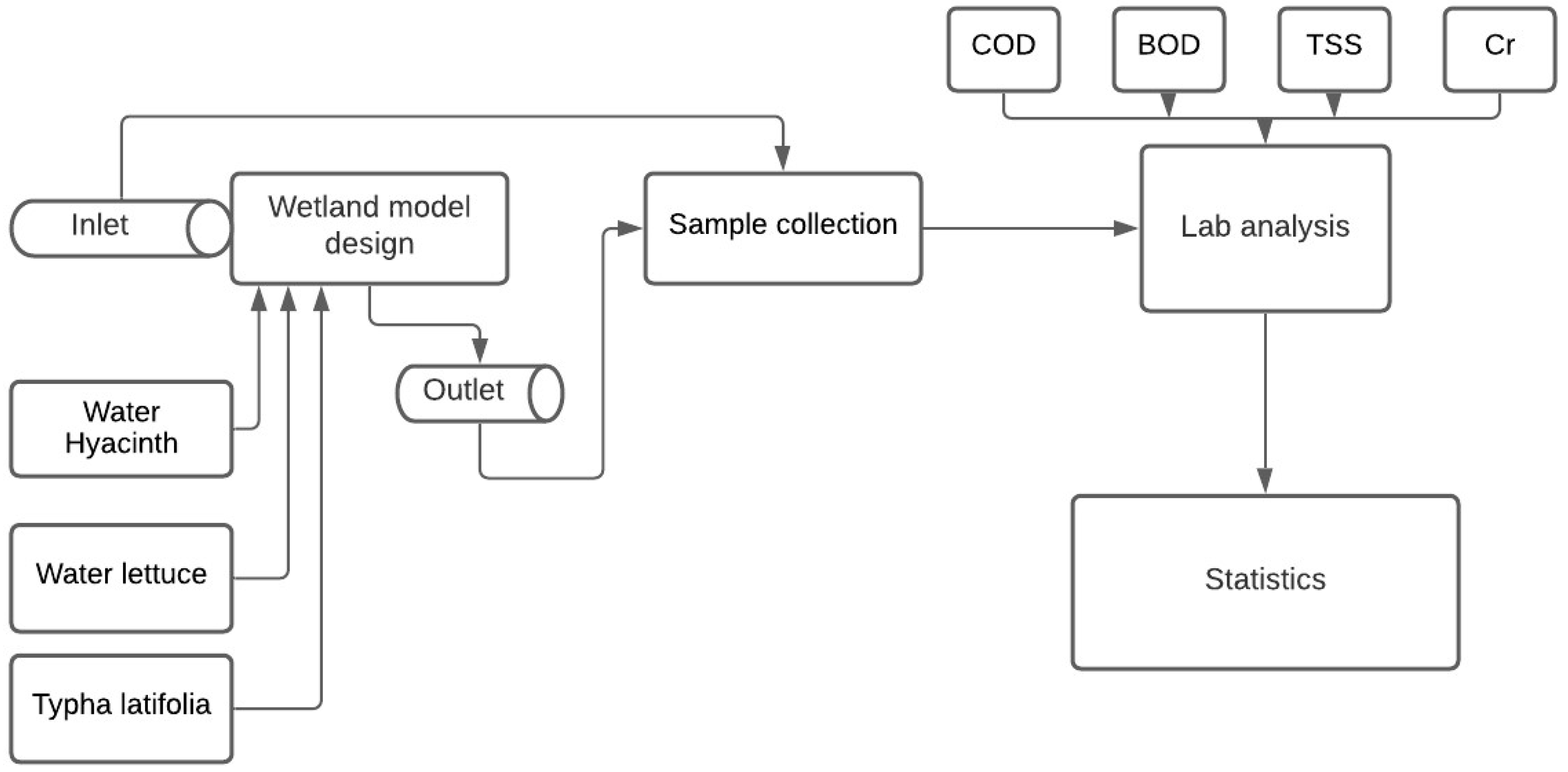
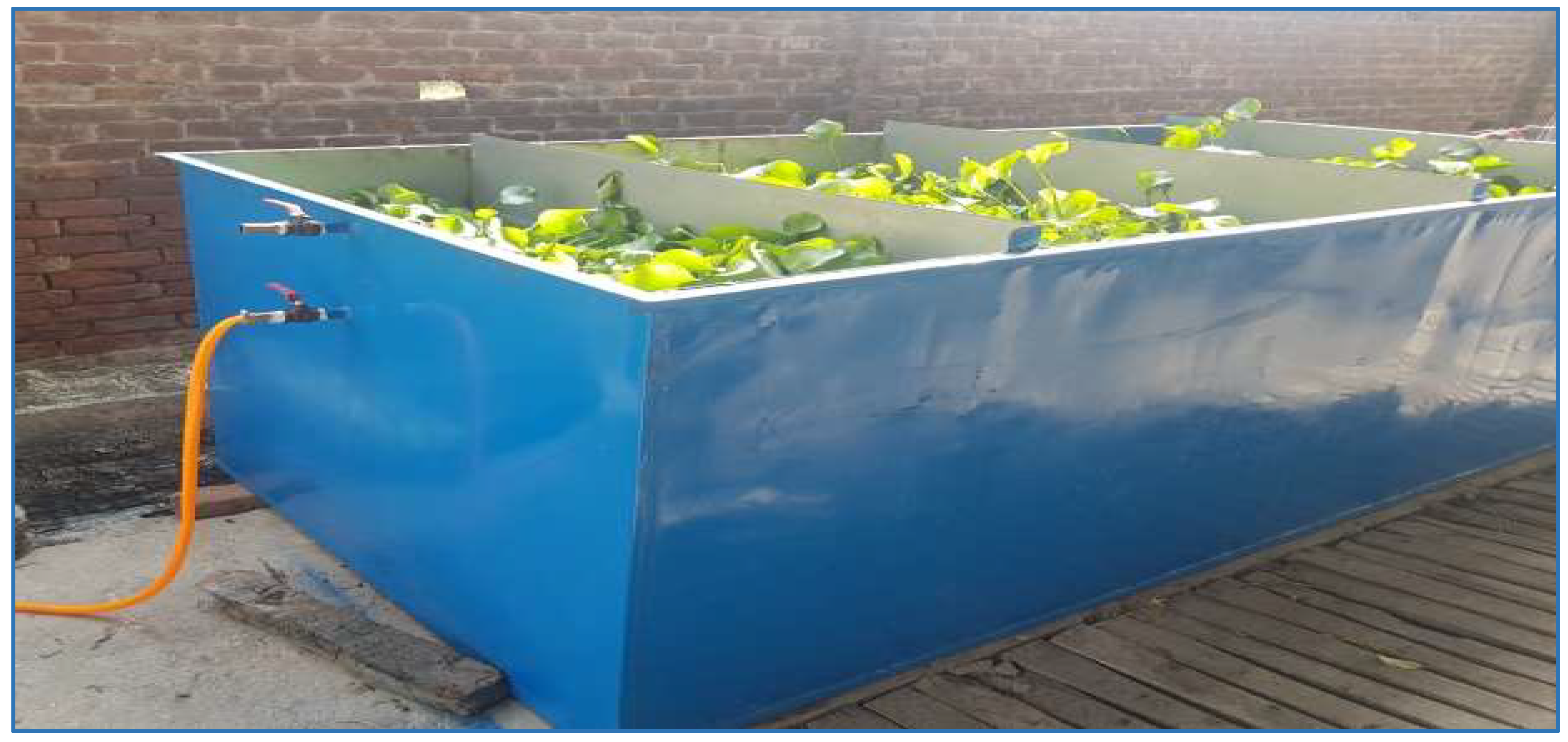

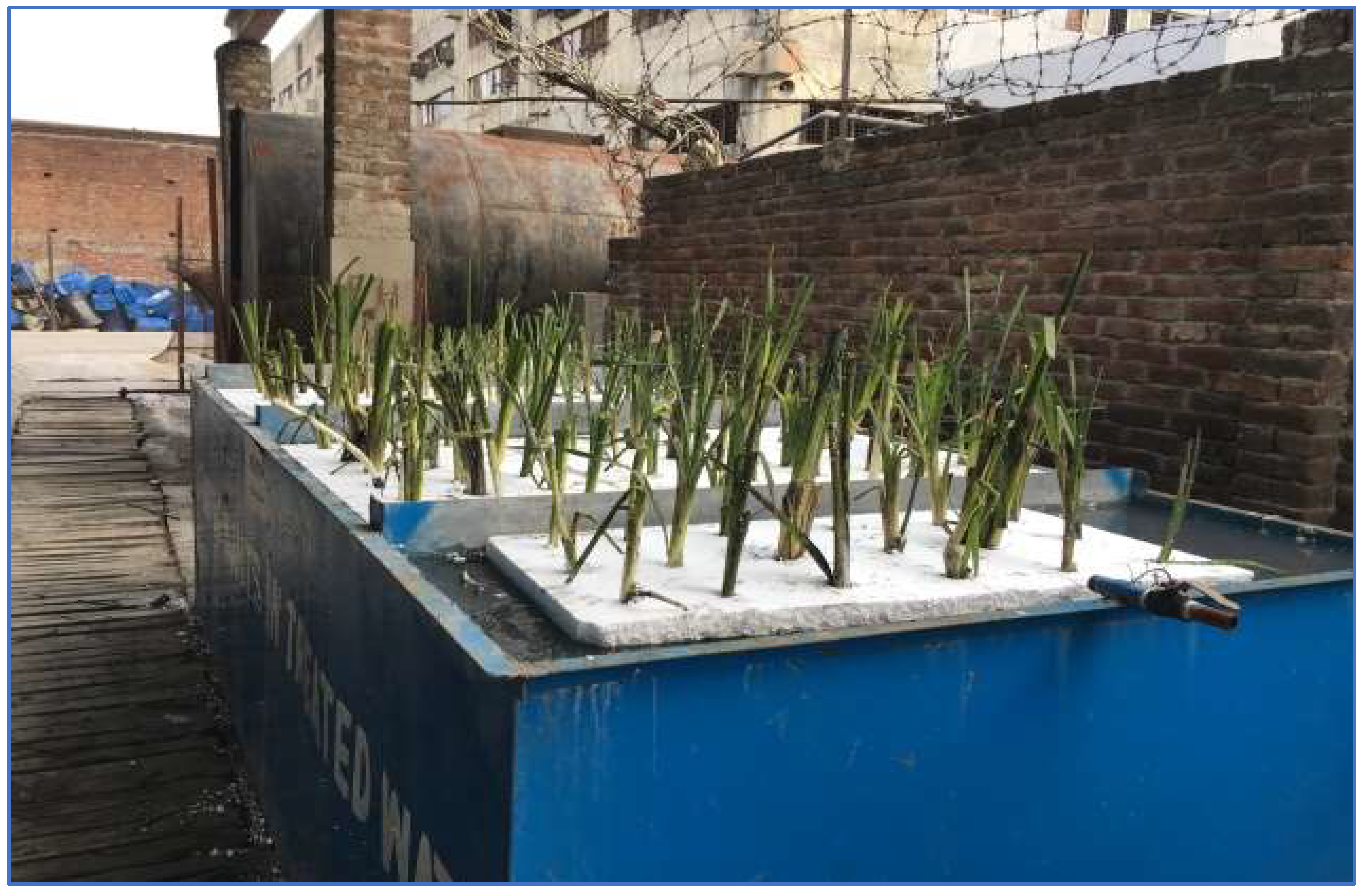
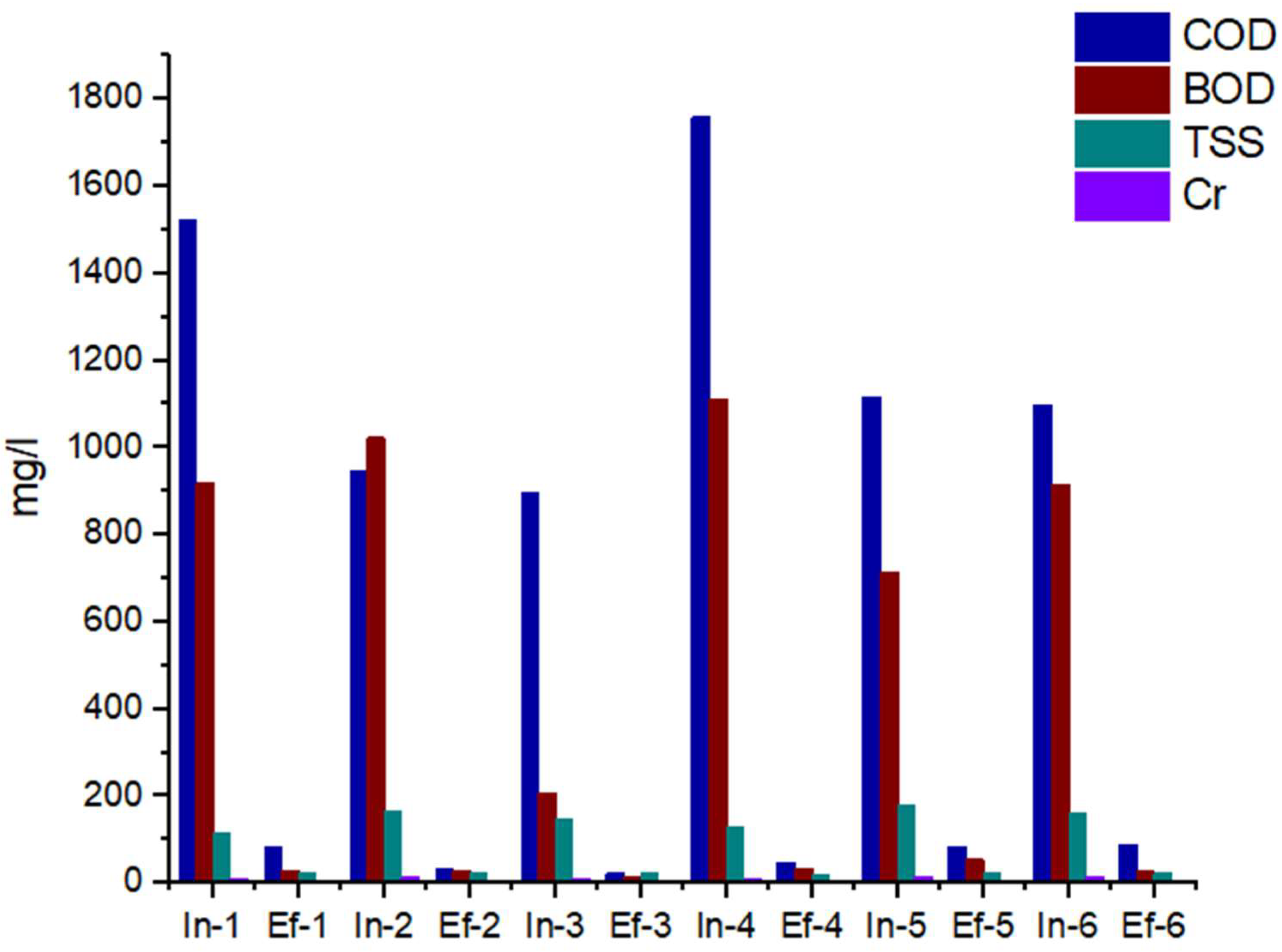
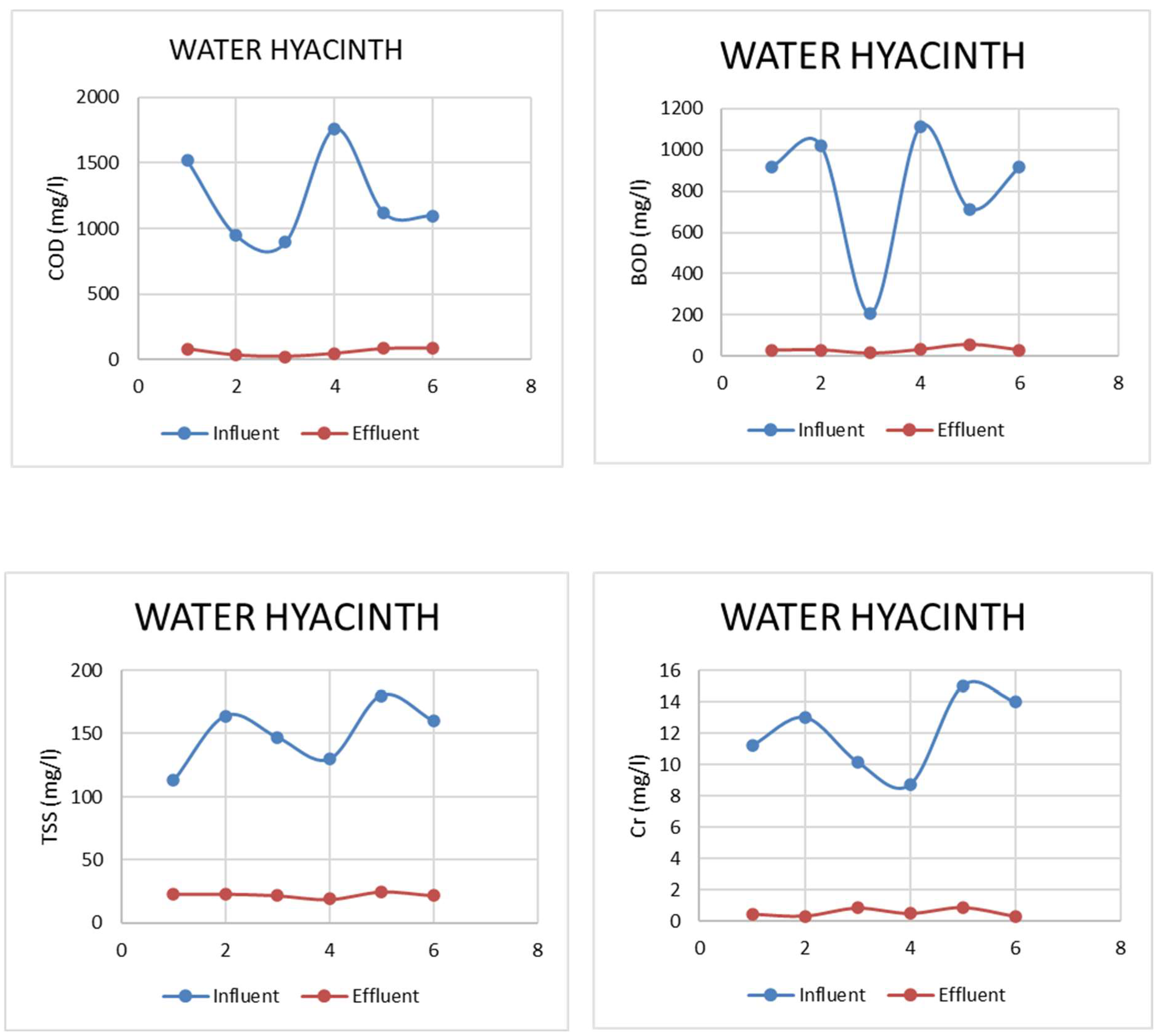

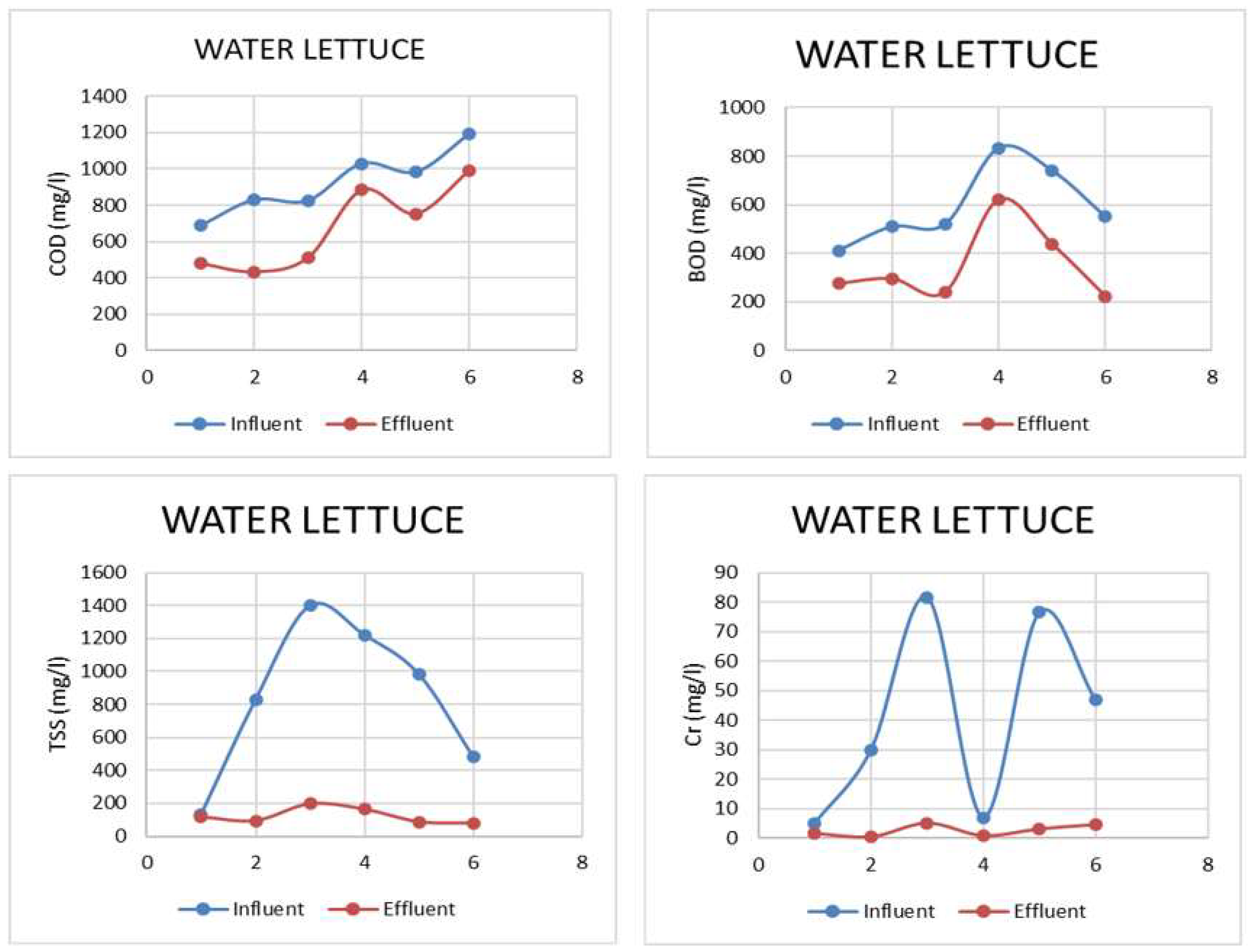
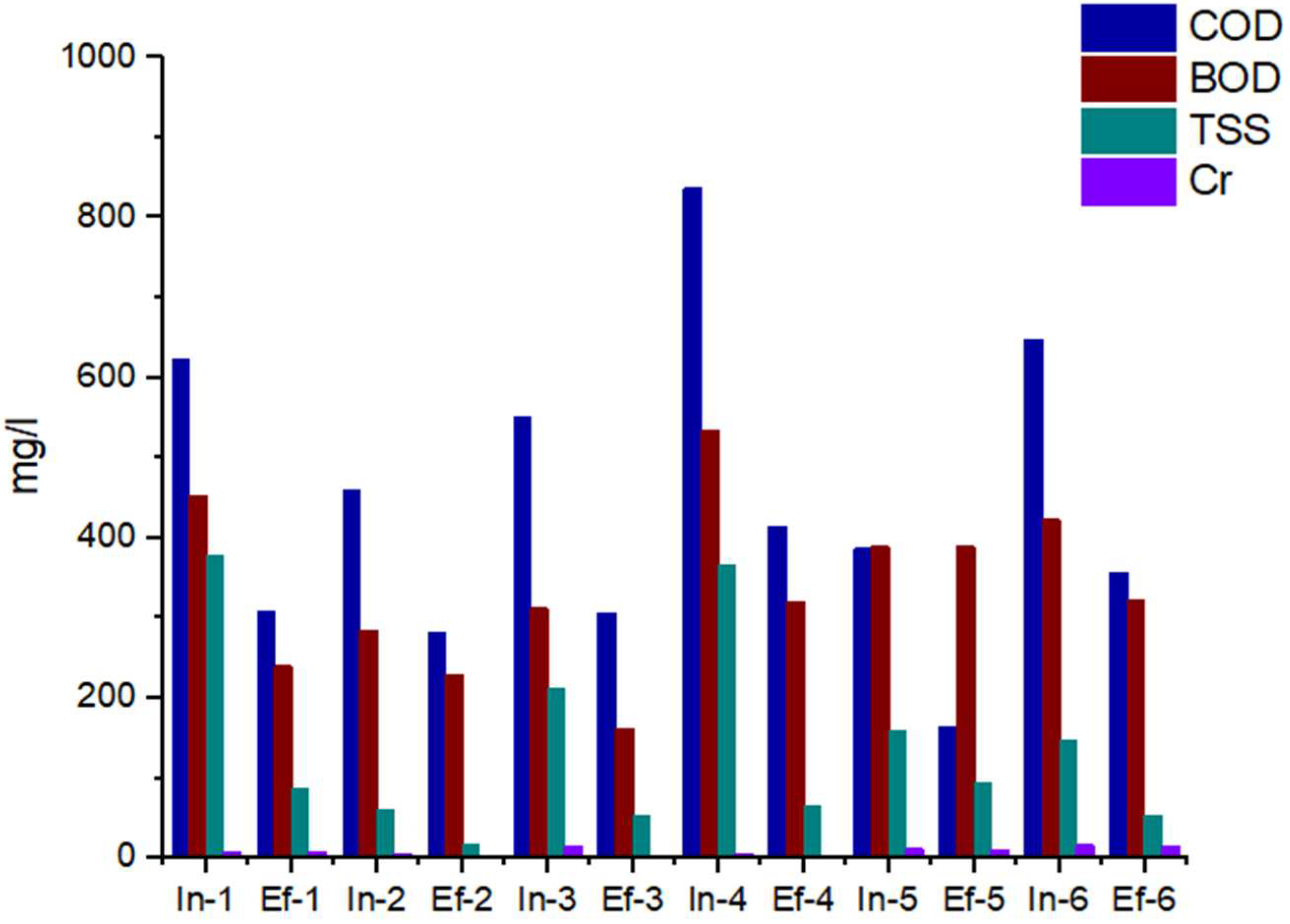
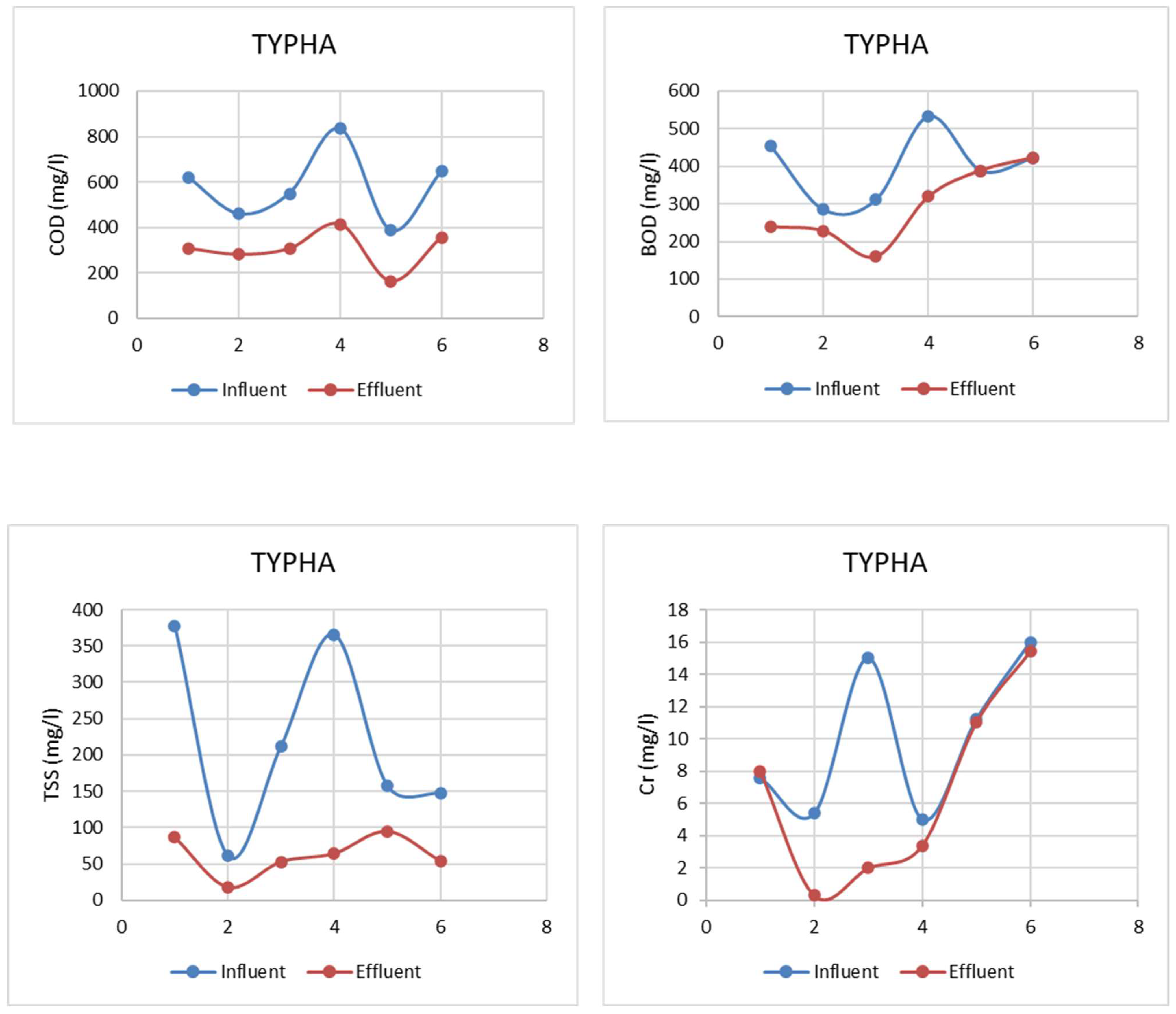
| Design | Measurement | Unit |
|---|---|---|
| Design flow | 0.72 | m3/day |
| Detention time | 6 | days |
| Width | 1.37 | M |
| Length | 3.6 | m |
| Depth | 0.84 | m |
| Area | 5.01 | m2 |
| Volume | 4.31 | m3 |
| Parameters | Average Inlet Concentration (mg/L) | Average Outlet Concentration (mg/L) | Removal Efficiency (%) |
|---|---|---|---|
| COD | 1222.16 | 59.83 | 95 |
| BOD | 814.7 | 31.76 | 96 |
| TSS | 149 | 22.41 | 85 |
| Cr | 12 | 0.67 | 94 |
| Parameters | Average Inlet Concentration | Average Outlet Concentration | Removal (%) |
|---|---|---|---|
| COD | 924.66 | 675.16 | 27 |
| BOD | 594.33 | 349.66 | 41 |
| TSS | 842.66 | 123.16 | 85 |
| Cr | 41.19 | 2.5 | 94 |
| Parameters | Average Inlet Concentration | Average Outlet Concentration | Removal (%) |
|---|---|---|---|
| COD | 583.83 | 305 | 48 |
| BOD | 399.33 | 276.83 | 31 |
| TSS | 220.33 | 61.82 | 72 |
| Cr | 10.04 | 6.68 | 33 |
| COD Removal Efficiency % | BOD Removal Efficiency % | TSS Removal Efficiency % | Cr Removal Efficiency % | |
|---|---|---|---|---|
| Water Hyacinth | 95 | 96 | 84 | 94 |
| Water lettuce | 27 | 41 | 85 | 94 |
| Typha latifolia | 48 | 31 | 72 | 33 |
Publisher’s Note: MDPI stays neutral with regard to jurisdictional claims in published maps and institutional affiliations. |
© 2022 by the authors. Licensee MDPI, Basel, Switzerland. This article is an open access article distributed under the terms and conditions of the Creative Commons Attribution (CC BY) license (https://creativecommons.org/licenses/by/4.0/).
Share and Cite
Younas, A.; Kumar, L.; Deitch, M.J.; Qureshi, S.S.; Shafiq, J.; Ali Naqvi, S.; Kumar, A.; Amjad, A.Q.; Nizamuddin, S. Treatment of Industrial Wastewater in a Floating Treatment Wetland: A Case Study of Sialkot Tannery. Sustainability 2022, 14, 12854. https://doi.org/10.3390/su141912854
Younas A, Kumar L, Deitch MJ, Qureshi SS, Shafiq J, Ali Naqvi S, Kumar A, Amjad AQ, Nizamuddin S. Treatment of Industrial Wastewater in a Floating Treatment Wetland: A Case Study of Sialkot Tannery. Sustainability. 2022; 14(19):12854. https://doi.org/10.3390/su141912854
Chicago/Turabian StyleYounas, Adeel, Love Kumar, Matthew J. Deitch, Sundus Saeed Qureshi, Jawad Shafiq, Sohail Ali Naqvi, Avinash Kumar, Arjmand Qayyum Amjad, and Sabzoi Nizamuddin. 2022. "Treatment of Industrial Wastewater in a Floating Treatment Wetland: A Case Study of Sialkot Tannery" Sustainability 14, no. 19: 12854. https://doi.org/10.3390/su141912854
APA StyleYounas, A., Kumar, L., Deitch, M. J., Qureshi, S. S., Shafiq, J., Ali Naqvi, S., Kumar, A., Amjad, A. Q., & Nizamuddin, S. (2022). Treatment of Industrial Wastewater in a Floating Treatment Wetland: A Case Study of Sialkot Tannery. Sustainability, 14(19), 12854. https://doi.org/10.3390/su141912854








